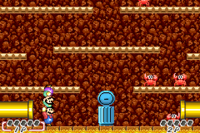Super Mario Advance (series): Difference between revisions
m (Text replacement - "{{Mario games}}" to "{{Super Mario games}}") |
m (Text replacement - "Mario" to "Super Mario") |
||
| Line 7: | Line 7: | ||
|parent=[[Super Mario (series)|''Super Mario'']] | |parent=[[Super Mario (series)|''Super Mario'']] | ||
}} | }} | ||
The '''''Super Mario Advance''''' series is a series of video game [[reissue]]s released only on the [[Game Boy Advance]]. It is a successor to ''[[Super Mario Bros. Deluxe]]'' on the [[Game Boy Color]],<ref >[http://www.nintendo.co.jp/nom/0103/031/index.html Interview on Nintendo's Japanese website], ''Nintendo''. Retrieved March 30 2015 (partial translation available [http://www.marioboards.com/index.php?topic=28694.msg1695195#msg1695195 here])</ref><ref>Marionova64 (July 30, 2020). [https://twitter.com/Marionova64/status/1288818364132057093 Super Mario Advance Unused Title Screen Voicelines]. ''Twitter''. Retrieved August 6, 2020.</ref> itself an indirect successor to ''[[Donkey Kong (Game Boy)|Donkey Kong]]'' on the [[Game Boy]]. Each game contains one of the classic ''[[Mario (franchise)|Mario]]'' sidescrollers, with improved graphics, sound, and additional features. Also, each game contains an updated version of the 1983 arcade game ''[[Mario Bros. (game)|Mario Bros.]]'' which adds an extra [[POW Block]] near the top of the stage. The series finished in 2003 with four games, although ''[[New Super Mario Bros.]]'', the first original 2D platformer since 1992, was developed as a response to requests for ''Super Mario Advance 5''.<ref>[http://web.archive.org/web/20101207010424/http://us.wii.com/iwata_asks/mario25th/vol3_page4.jsp Iwata Asks: Super Mario Bros. 25th Anniversary (archived)]</ref> | The '''''Super Mario Advance''''' series is a series of video game [[reissue]]s released only on the [[Game Boy Advance]]. It is a successor to ''[[Super Mario Bros. Deluxe]]'' on the [[Game Boy Color]],<ref >[http://www.nintendo.co.jp/nom/0103/031/index.html Interview on Nintendo's Japanese website], ''Nintendo''. Retrieved March 30 2015 (partial translation available [http://www.marioboards.com/index.php?topic=28694.msg1695195#msg1695195 here])</ref><ref>Marionova64 (July 30, 2020). [https://twitter.com/Marionova64/status/1288818364132057093 Super Mario Advance Unused Title Screen Voicelines]. ''Twitter''. Retrieved August 6, 2020.</ref> itself an indirect successor to ''[[Donkey Kong (Game Boy)|Donkey Kong]]'' on the [[Game Boy]]. Each game contains one of the classic ''[[Super Mario (franchise)|Super Mario]]'' sidescrollers, with improved graphics, sound, and additional features. Also, each game contains an updated version of the 1983 arcade game ''[[Mario Bros. (game)|Mario Bros.]]'' which adds an extra [[POW Block]] near the top of the stage. The series finished in 2003 with four games, although ''[[New Super Mario Bros.]]'', the first original 2D platformer since 1992, was developed as a response to requests for ''Super Mario Advance 5''.<ref>[http://web.archive.org/web/20101207010424/http://us.wii.com/iwata_asks/mario25th/vol3_page4.jsp Iwata Asks: Super Mario Bros. 25th Anniversary (archived)]</ref> | ||
==Multiplayer mode== | ==Multiplayer mode== | ||
Revision as of 16:20, May 28, 2023
| Super Mario Advance | |
|---|---|
| First installment | Super Mario Advance (2001) |
| Latest installment | Super Mario Advance 4: Super Mario Bros. 3 (2003) |
| Number of installments | 4 |
| Parent series | Super Mario |
The Super Mario Advance series is a series of video game reissues released only on the Game Boy Advance. It is a successor to Super Mario Bros. Deluxe on the Game Boy Color,[1][2] itself an indirect successor to Donkey Kong on the Game Boy. Each game contains one of the classic Super Mario sidescrollers, with improved graphics, sound, and additional features. Also, each game contains an updated version of the 1983 arcade game Mario Bros. which adds an extra POW Block near the top of the stage. The series finished in 2003 with four games, although New Super Mario Bros., the first original 2D platformer since 1992, was developed as a response to requests for Super Mario Advance 5.[3]
Multiplayer mode
Any game in the Super Mario Advance series can link up to other Game Boy Advances that also have any of the said four games. This allows two to four people to play a version of Mario Bros., with upgraded graphics, control, and sound. All players are Marios, but they wear different colored uniforms (red, yellow, green, and blue), though they still have the letter "M" on their caps. Players can pick each other up and throw each other, though a grabbed player can escape another's grasp. In "Classic Mode", the players cooperate in defeating the enemies like in the single player mode. In "Battle Mode", the players start off as Super Marios and compete against each other to collect five coins first by defeating enemies or being the last one standing. An invincible, flame-throwing Bowser appears in bonus rounds.
If there are only two players in the Battle Mode, there will be a garbage can at the bottom. Players can be thrown in the garbage can. A player in the garbage can is stuck there for several seconds, putting them at a disadvantage, but they will come out with an item that may help them fight their rival. Players can receive a Koopa Shell, POW Block, Fish Skeleton, or an Egg. The Egg can yield either a coin, a Heart, or a Starman.
This mode is also included in Mario & Luigi: Superstar Saga. There are very minor differences between this version, the one found in the first Super Mario Advance, and the rest of the games in the Super Mario Advance series.[4]
Games
| Title | |
|---|---|
| Cover and release date | Synopsis |
| Super Mario Advance | |
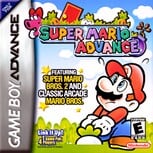 |
Super Mario Advance features the classic game Super Mario Bros. 2, based heavily on the Super Mario All-Stars port of the game, although in the game it is referred to as Super Mario 2. Nintendo's decision to choose this title as a Game Boy Advance launch game was seen by some as misguided; GameSpot in particular thought that Super Mario Bros. 3 or Super Mario World would have been far better choices for a launch title considering their popularity (both of these titles would ultimately be remade as part of the SMA series). Nonetheless, IGN praised the choice, calling it "one of the most polished and creative platformers of the era," and it was a best-selling GBA launch game.
Later, the game would become a part of the Player's Choice lineup for the Game Boy Advance as one of the system's first three Player's Choice games (along with Mario & Luigi: Superstar Saga and Yoshi's Island: Super Mario Advance 3). |
| Super Mario World: Super Mario Advance 2 | |
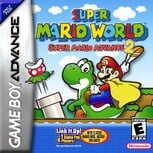 |
As the name suggests, Super Mario World: Super Mario Advance 2 features Super Mario World. It is the second video game in the Super Mario Advance series. |
| Yoshi's Island: Super Mario Advance 3 | |
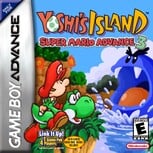 |
Yoshi's Island: Super Mario Advance 3 is a port of Super Mario World 2: Yoshi's Island for the Game Boy Advance. It is very much like the original version, though it has six new levels and Yoshi's Story sound effects. |
| Super Mario Advance 4: Super Mario Bros. 3 | |
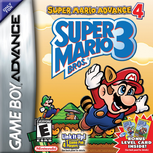 |
In 2003, the fourth and final entry in the Super Mario Advance series, Super Mario Advance 4: Super Mario Bros. 3, was released for the Game Boy Advance. It is a heavily updated version of Super Mario Bros. 3, as the name suggests. However, it boasts similar graphics and sound to the All-Stars version. It features a save system similar to the Super Mario All-Stars save system, except temporary saves may now be done anywhere.
This game's largest added feature (except in the European version) is compatibility with the e-Reader and its cards. These cards can be scanned into the game and function as new levels (World-e), instant power-ups, or demos. One power-up card features a power-up that was not found in any other Mario game until Super Mario 3D Land: the Boomerang. The 2016 Virtual Console release would fully include these levels and make them available worldwide for the first time. The levels were again made available in the game's release on the Game Boy Advance - Nintendo Switch Online service during its 2023 launch. |
Changes from the original games
- In Super Mario Advance, Super Mario World: Super Mario Advance 2 and Super Mario Advance 4: Super Mario Bros. 3, there are added voice clips for each player character and most bosses.
- In line with the current standard, Super Mario Advance, Super Mario World: Super Mario Advance 2 and Super Mario Advance 4: Super Mario Bros. 3, now also refer to Princess Toadstool as "Peach" (as introduced to the West in Yoshi's Safari and retained in Super Mario 64 onward).
- In Super Mario World: Super Mario Advance 2, Luigi is playable as the first player, and has his special attributes from Super Mario Bros. 2, with a higher jump, and lower traction.
- In Super Mario Advance 4: Super Mario Bros. 3, some levels have been slightly altered to fit on the GBA screen.
- In Super Mario Advance 4: Super Mario Bros. 3, there are additional levels based on e-Reader cards.
Gallery
American logo of Super Mario Advance
American logo of Yoshi's Island: Super Mario Advance 3
Japanese box art of Super Mario Advance 4: Super Mario Bros. 3
Names in other languages
| Language | Name | Meaning |
|---|---|---|
| Japanese | スーパーマリオアドバンス[6] Sūpā Mario Adobansu |
Super Mario Advance |
References
- ^ Interview on Nintendo's Japanese website, Nintendo. Retrieved March 30 2015 (partial translation available here)
- ^ Marionova64 (July 30, 2020). Super Mario Advance Unused Title Screen Voicelines. Twitter. Retrieved August 6, 2020.
- ^ Iwata Asks: Super Mario Bros. 25th Anniversary (archived)
- ^ The Cutting Room Floor: Mario Bros. Classic Retrieved November 11, 2021.
- ^ a b c d GameFAQs Retrieved November 14, 2010
- ^ ゲームボーイアドバンス Nintendo Switch Online「スーパーマリオアドバンス」シリーズの3作が5月26日に追加。. Nintendo Japan. Retrieved May 18, 2023.
